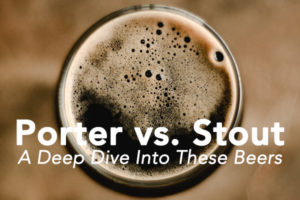Pilsner Definition
Did you know that the world’s most imitated beer- Pilsner- is actually just a corrected lager?
Yes, you’ve read that right.
In case you still don’t know, Pilsner is a type of lager beer.
While lager has been around for quite some time, Pilsner is still a relatively recent innovation in the beer world.
Take the sleek, clean, and crisp lager, add some badass Saaz hops, pure soft water, lager malt, and maybe a couple of decoctions and you’ve got yourself a classic Pilsner.
As opposed to its parent, the “lager”…
Pilsner beer has a much heavier flavor profile, with a stronger taste and aroma coming from the Saaz hops, a clearer golden look, and a clarity that the lager didn’t have in the earlier times.
It also boasts of a little kick of spice thanks to the Saaz, making it a great favorite especially among beer aficionados and adventurous drinkers.
On the other hand…
While the difference between lager beer and Pilsner may seem great, they actually have the same fermentation process, save for the additionals that turn the lager into a Pilsner.
Both of these two types of beer are made through the bottom fermentation process at a cooler temperature, although the Pilsner has a more demanding and thorough fermentation process to achieve the taste and clarity that’s unique only to Pilsner beer.
But if you put these things aside, what else makes this crowd favorite special?
Only one way to find out.
The Original Pilsner
What’s funny…
… is that Pilsner’s origin was actually a result of a community’s dissatisfaction over the ancient murky and skunky lager made in the earlier times.
We know by now that lager has been produced by Bohemian brewers and people from Germany since the middle ages by bottom-fermenting the wort and letting it mature in a cool temperature either in dug-up cellars or caves.
But the popularity of this drink didn’t mean that it’s that good.
With limited knowledge about how strains of yeasts work and ferment, the ancestor of our favorite Pilsner today was actually a dark, cloudy, and murky alcoholic beverage that’s even possibly served spoiled, too, so it tasted nasty most of the time.
It took them hundreds of years before the folks in the city of Plzen realized that the quality of the beer sucked and that they can’t tolerate it anymore.
And so it happened…
…the great flooding of lager beer in the streets of the city one day in 1838.
Clearly, beer was a darn big deal for the nation so the city officials were quick to act, and soon, a city brewery was established and a 26-year old Bavarian brewing junkie was imported to appease the seething crowd.
And appeased they were.
The city brewery would survive to be known as Pilsner Urquell today.
Yes, that particular beer your grandad loved.
But at that time, it’s a collective facility that was run by some of the city’s independent brewers led by the master brewer Bavarian Josef Groll.
They worked to improve the beer’s quality including the taste and its color.
And the difference was astounding enough to drive the whole of Europe ecstatic!

With a newly-improved kilning method and the addition of the noble Saaz hops, pale malt, and most especially, pure soft water, a new breed of lager was created and it’s a big hit among the citizens and nearby countries.
The pale malt and the yeast strain used resulted in an almost perfectly clear beverage that’s far from the dark and muddy ones people drank years before.
Aside from that…
This soft water used in Pilsner Urquell only had a total of about 50ppm, or in other words, chemical or contaminate per unit volume of the water.
To give you an idea…
Other water used in lager-making has about 1,200ppm.
That means that the water used for the newly-made Plzen Pilsner contained fewer minerals like calcium and chloride.
These minerals interact with the hop, making the beer’s bitterness much sharper so using soft water regulates this bitterness, turning it into a well-rounded flavor.
What’s cooler…
…is – it also happened that the production of glassware became cheaper so ordinary families were finally able to purchase glass mugs and vessels that perfectly displayed Pilsner’s beautiful light to golden color with the dense head of foam.
Soon word came about and Pilsner became a favorite in pubs across Europe and later on, in other countries like America, as well.
There are literally a hundred types and names of Pilsners today but beer lovers will always look at the Saaz hopped-Pilsner as the only true and original Pilsner beer.

The ultimate guide to Pilsner:
Just like how there are so many types of beer available today, the many varieties of Pilsner on the market also make getting acquainted with this artistic type of sud quite tricky.
Fortunately…
…once you get to know the basics, choosing your Pilsner won’t be as hard and intimidating anymore.
Here are some of the things you need to know if you’re planning to check this amazing beverage out so you won’t feel like a total noob when ordering it in your favorite place. And, if you plan on brewing your own at home with one of these electric all-in-one home beer brewing systems.
4 Types of Pilsners
- Czech- Style Pilsner- From the original home of Pilsner Urquell, the Czech style Pilzner has a light straw to a beautiful golden color with a low to medium hoppy taste, resulting in an overall lighter flavor profile.
- German Pilsner- From the generally beer-loving nation, the German “Pils” type has a stronger flavor with moderate to high hop presence with a hint of sweetness. It has an aroma that’s just as strong with the same light straw to golden color as the Czech Pilsner.
- European- Style Pilsner- Most European Pilsners are made to be much sweeter than the renegade Czech and German ones.
- American- Style Pilsner- Brought by the immigrants in the 19th century, the American Pilsner retained most of its German characteristics and quality with the addition of rice or corn to either cut production costs or play up with the flavors.
Pilsner Urquell, Bitburger, Jever Pilsener, Oskar Blues Mama’s Little Yella Pils, Sam Adams Hallertau Imperial Pilsner, Lagunitas, and Victory Prima Pils are just a few of the most popular names in the Pilsner market today.
Lager On Steroids
Considering its origin and difference from the parent drink, Pilsner is basically a lager beer on steroids.
Think of it this way…
While lager beer is your straightforward, no-nonsense, and lowkey relative, Pilsner is that artistic and free-spirited cousin who’s always up for challenges.
Deviating from everything old and traditional, Pilsner uses a louder kind of hops that’s made more sophisticated and milder by the touch of the soft water.
The result is a genius of a concoction. Pilsner is strong, just like the darker types of ales and lagers, but made more rounded by the water used.
That’s why it’s no surprise that the most adventurous drinkers always prefer Pilsner as their go-to comfort beverage more than the heavier amber lager beer or ale.

The Future of Pilsner (Pils) Style in America:
As much as innovation and artistry seem to dominate every market today- including the beer-making industry- old-time Pilsner aficionados can rest assured that the well-loved classic flavor can still survive and remain for many more years to come.
Aside from its taste and appearance, a considerable amount of changes can also be noted in Pilsner’s production process.
For one…
…is the use of stainless steel systems and storage.
Some hardcore Pilsner drinkers remarked that Pilsner produced and matured in a stainless steel setting tastes a world away different from the traditional one.
Fortunately for them, the original Pilsner’s legacy seems to be going strong and will continue to do so as the trends in the past few years lean more on traditional and rustic processes and aesthetics.
Many play-ups with the beer’s malt and hop ratio are also starting to appear in the brewing scene today.
But as most Pilsner lovers would surely agree, the classic Pils has it all: crispness, lightness, and just a little bit of spice and sometimes, floral notes, and of course, the heavy head of foam, making it the comfort beverage that many beer drinkers will always go to at the end of the day.
Conclusion: Last Word On Pilsner
Bottom line – they say that when it comes to beers, it’s only either black or white…there’s no gray area.
But considering the characteristic of the most imitated beer in the world, it seems like Pilsner is bordering on simple and traditional to loud and artsy so it’s no surprise that the good ole’ Pils is now hugely popular with drinkers of all ages and experiences.
As for me…
It’s like that one friend who perfectly understands you and can go with the flow whatever your mood may be.
What’s your favorite Pilsner brand? What flavor do you prefer?
Let me know through our social media and let’s talk over a tall cold glass!




